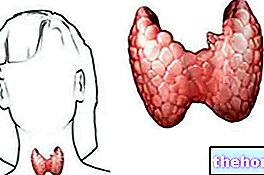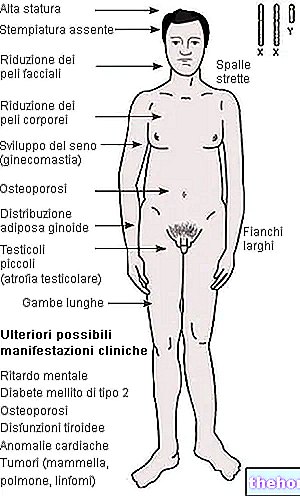Generality
Hyperparathyroidism is a clinical condition related to the excessive synthesis and secretion of parathyroid hormone.
It therefore involves the parathyroid glands, four small glands located two by two on the dorsal aspect of the thyroid, similar to lentils and responsible for the synthesis of parathyroid hormone (PTH) and its release into the blood; in turn, this protein hormone has a hypercalcemic effect, increasing the mobilization of calcium from the bones, stimulating intestinal absorption (mediated by vitamin D) and decreasing urinary excretion.
For this reason, most forms of hyperparathyroidism are accompanied by an increased concentration of calcium in the blood, a condition known as hypercalcemia.
The biological role of paratharmone is counteracted by calcitonin, which after being synthesized and secreted by the thyroid gland favors the deposition of calcium in the bones.
Insights

Causes
Hyperparathyroidism can result from:
- autonomous and exaggerated secretion of parathyroid by one or more parathyroid glands (primary hyperparathyroidism);
- excessive secretion of parathyroid hormone - in the absence of an inherent disease of the parathyroid glands - caused by the response to hypocalcemia (secondary hyperparathyroidism).
Primary hyperparathyroidism
In 85% of cases the origin of primary hyperparathyroidism is linked to a benign tumor (adenoma) of the parathyroid glands. Other times (14% of cases) the condition is related to the increase in volume of one or more glands; in these circumstances we speak of parathyroid hyperplasia. Very rarely (1% of cases), at the origin of the problem there is instead a malignant tumor, called parathyroid carcinoma. Whatever its origin, the excessive secretion of parathyroid hormone causes a rise in calcium in the blood; in the long run, bones tend to demineralize and fracture easily, while the amount of dietary calcium absorbed at the enteric level tends to increase. Consequently, urinary excretion of calcium (although in physiological conditions the parathyroid hormone has the opposite effect) and phosphorus also increases, exposing the subject to a greater risk of kidney stones.
Secondary hyperparathyroidism
Secondary hyperparathyroidism reflects the hypersecretion of parathyroid hormone in response to the reduction of calcium levels in the body; this compensatory parathyroid hyperactivity - which results in hyperlplasia of the same glands with parathyroid hormone hypersecretion - may therefore be due to a deficient dietary intake of calcium and / or vitamin D, as well as an important defect in intestinal absorption of the mineral (malabsorption syndrome, as occurs in celiacs or in individuals suffering from chronic intestinal inflammatory diseases). The most frequent cause of secondary hyperparathyroidism, at least in industrialized countries, is however represented by "chronic renal failure; in fact, we remember that the kidney plays a fundamental role in the activation of vitamin D. Furthermore, in chronic renal failure the increase in phosphatemia favors a further and progressive reduction of calcium.
Risk factors
The risk of hyperparathyroidism is slightly higher for women than for men (3: 2), especially in the first years after menopause. However, individuals who do not get enough calcium and vitamin D in their diet are also at greater risk of developing the disease. Finally, hyperparathyroidism most frequently affects people affected by multiple endocrine neoplasia (a rare inherited disease), those who have undergone radiation treatment in the neck area, and individuals on lithium therapy (a drug often used in the treatment of bipolar disorder).
Diseases of the parathyroid glands
Problems with playing the video? Reload the video from youtube.
- Go to the Video Page
- Go to Wellness Destination
- Watch the video on youtube
Other articles on "Hyperparathyroidism"
- Hyperparathyroidism: symptoms and diagnosis
- Hyperparathyroidism: treatment
- Hyperparathyroidism - Medicines for the treatment of Hyperparathyroidism
















.jpg)











